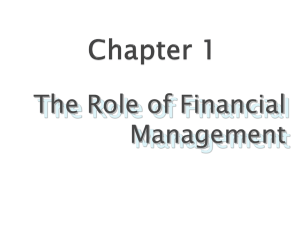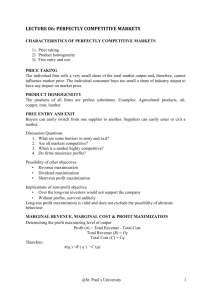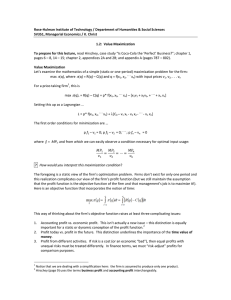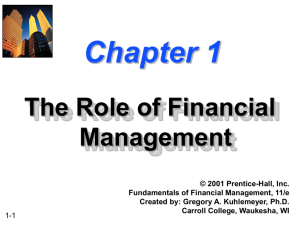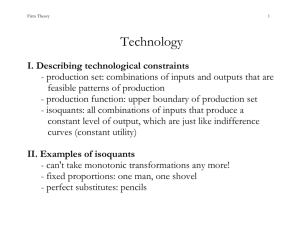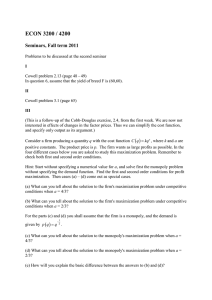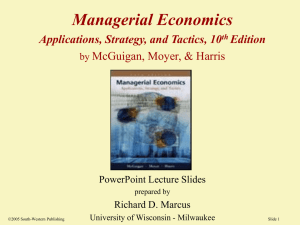Profit Maximization
advertisement
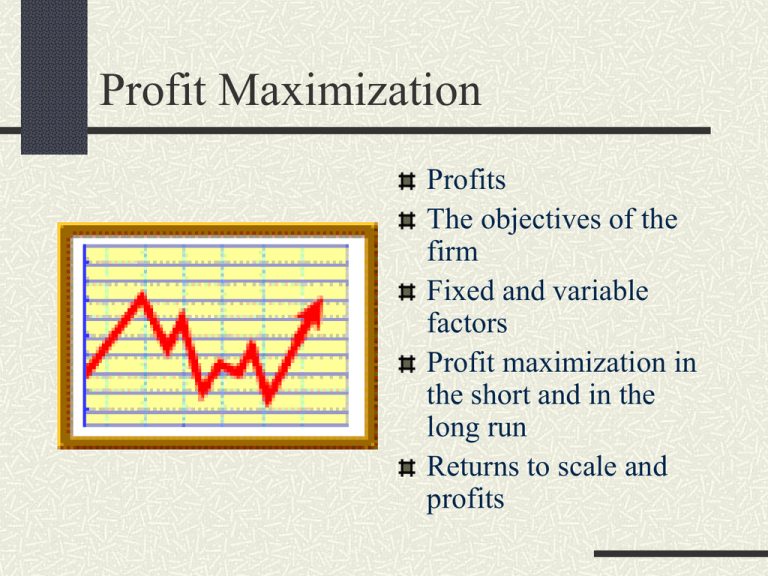
Profit Maximization Profits The objectives of the firm Fixed and variable factors Profit maximization in the short and in the long run Returns to scale and profits Competitive Markets In a competitive market firms take input and output prices as given Firms are “small” relatively to the market, so that their decisions do not affect market prices Q: When is this assumption reasonable? Product Homogeneity A: In markets where firms produce (almost) identical products When products are homogeneous (agricultural products, raw materials, etc.) no firm can raise its price without losing most of its customers Differentiated products: a firm can set its price without losing all customers The Objective of the Firm Q: What is the objective of the firm? A: The maximization of profits Q: How are profits defined? Defining Economic Profits Profits are defined as revenues minus costs E.g. a firm produces light bulbs using labor and capital pbY wL L wK K Defining Economic Profits Labor: suppose that the owner of the firm works in the firm Q: Should costs take the owner’s labor into account? A: Yes, we need to take into account the opportunity cost for the owner of not employing his/her labor somewhere else Defining Economic Profits Q: How should you take into account the cost of using physical capital? A: Since factor inputs are measured in flows (e.g. labor and machine hours per week), the unit cost of using physical capital should be its rental rate Fixed and Variable Factors Short run: there are fixed factors that the firm is obliged to employ. E.g.: firm has signed a contract to lease space in a building for certain number of months. Even if the firm decides not to produce it still has to pay lease. Fixed and Variable Factors Long run: all factors of production are variable. Variable factors are factors that the firm employs and pays for only if it decides to produce something. E.g.: labor In the long run all factors are variable: firm can always decide to use zero inputs and produce zero output, i.e., go out of business. Short Run Profit Maximization Let’s consider the problem of a consulting firm that has rented 3000sq feet in a building (fixed factor) It has to decide how many consultants xl to hire Production function (output in a year): y 3000 0.2 xl 0.6 Short Run Profit Maximization Suppose the salary of a consultant is $70K per year, office space costs $1000 per square foot per year, and the firm sells its consultation services at $100K each Problem of the firm in the short run: max 1003000 0.2 xl 0.6 70 xl 3000 Short Run Profit Maximization Problem of the firm in the short run: max 1003000 0.2 xl 0.6 70 xl 3000 First order condition: 1000.63000 xl 0.2 0.61 70 0 Short Run Profit Maximization First order condition: 1000.63000 xl 0.2 0.61 70 Interpretation: p( MPL ) salary Short Run Profit Maximization First order condition: 0.61003000 0.2 xl 0.61 70 Solve this equation for number of consultants. Then get output and profits : xl 37 y 43 1290K Isoprofit Lines The firm’s profits are given by: 100 y 70 xl 3000 Isoprofit line: 7 y xl 30 100 10 Isoprofit Lines y Isoprofit lines: 7 y xl 30 100 10 43 Production function: y 3000 0.2 37 xl xl 0.6 Change in Salary: 70K to 80K y Isoprofit lines: 8 y xl 5 100 10 43 Production function: 35 y 3000 0.2 27 37 xl xl 0.6 Profit Maximization in the Long Run In the long run the level of inputs is variable: max 100xo 0.2 xl 0.6 70 xl 1xo First order conditions: 1000.6xo xl 70 0.21 0.6 1000.2xo xl 1 0.2 0.61 Profit Maximization in the Long Run First order conditions: 1000.6xo xl 70 0.21 0.6 1000.2xo xl 1 0.2 0.61 Divide first equation by second: xo 3 70 xl Profit Maximization in the Long Run First order conditions: 1000.6xo xl 0.61 0.2 70 xo xl 3 70 Replace second equation into first: 5 70 6 xl 11 3 7 Profit Maximization in the Long Run Find both inputs: 5 70 6 xl 11 3 7 70 xo 11 257 3 consultants square feet Profit Maximization in the Long Run Find output and profits: y 257 0.2 11 0.6 13 100 y 7011 257 273K Factor Demand Curves In the example above, the firm chooses inputs so that: pMPL xo , xl salary pMPO xo , xl rent Factor Demand Curves Solve these equations to get factor demand curves: xl Dl salary xo Do rent Inverse Factor Demand Curves Express what the factor price would have to be for factor demand to be at a certain level: salary f l xl rent f o xo Find Factor Demand Curve in the Example From first order conditions: 1000.6xo xl 0.61 0.2 wl xo xl 3 Solve for xl : 5 60 1 xl 4 3 wl wl Find Inverse Factor Demand Curve in the Example Solve for wl : 5 60 1 xl 4 3 wl Get: 127 wl 0.25 xl Diagram of Inverse Factor Demand for Consultants wl 70K 11 xl
